Foot and Leg Pain Centre
Leading Children's Podiatrists Westmead
Helping little feet thrive with care
Paediatric Podiatrist
Are sore feet or legs a recurring issue for your child?
Dr Angus Chard PhD, a Certified Sports Podiatrist and the owner of the Foot and Leg Pain Centre near Westmead, brings a wealth of expertise to children’s podiatry. With his Doctorate specialising in Lower-Limb and Foot Musculoskeletal Medicine, focusing on Paediatric and Sports Injuries, Dr Chard is highly skilled in managing children’s foot and leg conditions. He personally supervises the treatments offered by the clinic’s podiatrists, all of whom share a keen interest in paediatric podiatry. Dr Chard’s unique combination of expertise and dedication ensures outstanding care for children.
Paediatric Podiatrist Westmead
Recognising that medical visits can be overwhelming for children, we prioritise making the environment as comfortable and inviting as possible. Our goal is to replace fear with reassurance and deliver the highest level of care to each little patient.
Michael Chard, a Licensed Service Dog, provides incredible comfort and emotional support with his gentle scratches and cuddles. His calm and loving nature helps reduce anxiety in children and brings peace to those who need it most.
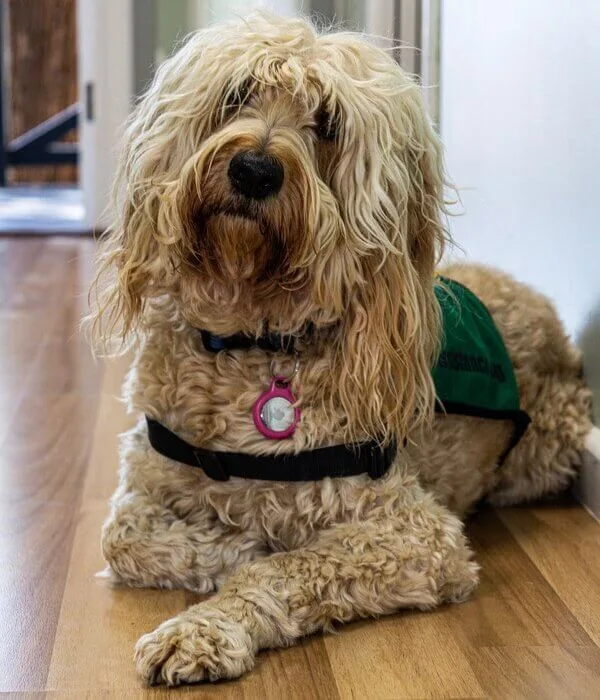
How We Support You
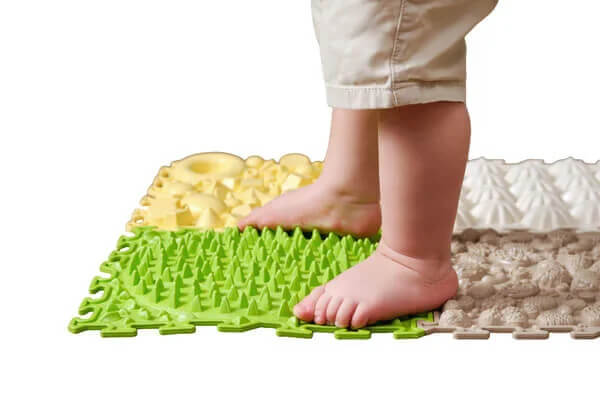
Flat Feet
Flat feet are frequently seen in young children after 18 months and generally resolve on their own. In certain cases, though, they may persist and cause long-term issues. Conducting an early assessment is vital, much like routine eye or dental checks, to detect and manage conditions early. Post-assessment, children can be monitored to ensure they grow out of any potential problems.
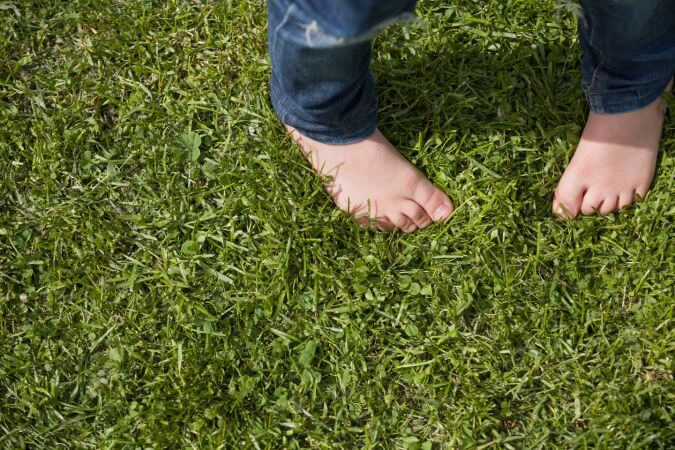
Intoe Walking
Intoe walking, also known as pigeon toes, is a common condition in young children and often corrects itself by the age of 4. If it persists beyond this age, it may result in instability, discomfort, or changes in movement patterns. Early intervention can help ensure proper development and avoid potential problems.
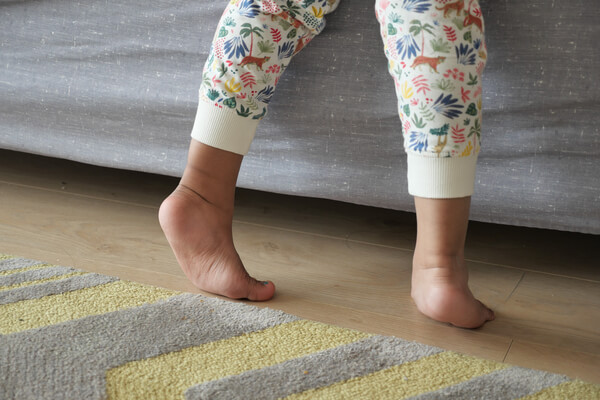
Toe Walking
Although toe walking is normal in toddlers, persistent cases beyond age 4 can indicate conditions such as tight muscles or neurological problems. If untreated, it may cause knee, back, or joint pain. Early assessment can help identify the cause, prevent future issues, and promote healthy movement.
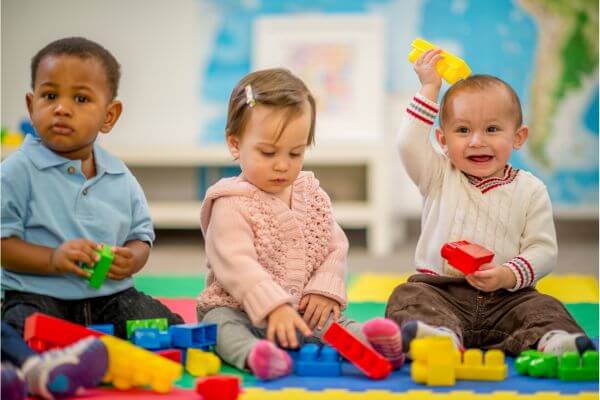
Late or Non Walkers
Children who haven’t started walking by 18 months may face underlying foot or leg challenges. Early assessment and periodic measurements help track and support their developmental milestones.
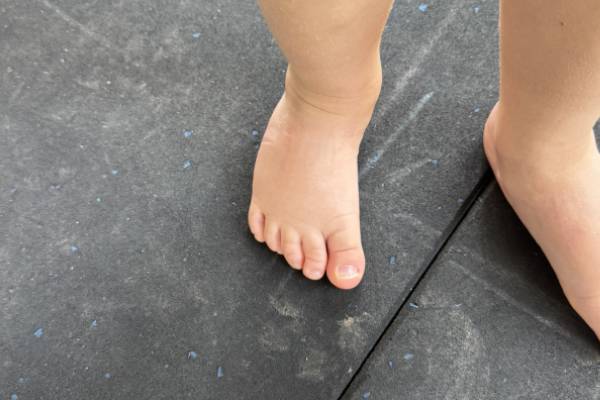
Banana Foot
Known as banana foot, metatarsus adductus results in a curved-in foot shape, usually due to pressure from the foetal position. While it often resolves on its own by age 4, addressing it early, ideally before age 2, is vital. Neglecting the condition can lead to structural abnormalities and chronic aches.
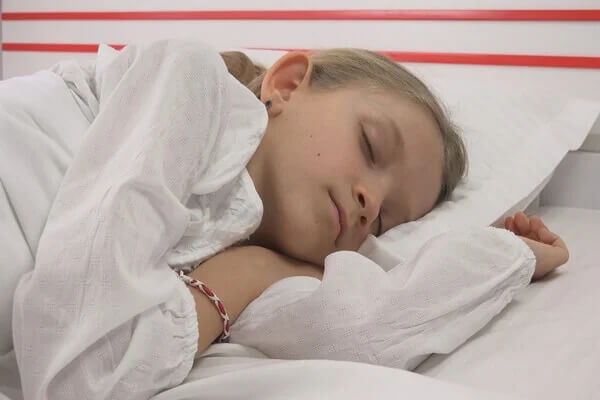
Growing Pains
Generalised leg aches and pains are often deemed normal shortly after a growth spurt, but experts agree that pain lasting beyond two months is abnormal. These issues can be effectively treated when identified as gross muscle overuse syndromes. Growing pains don’t need to be part of your child’s life—modern research shows they’re not an inevitable part of growing.

Severs
Sever’s disease, which typically occurs in children between 7 and 12 years old, is a growth-related condition causing heel pain. While it’s often linked to activity levels, inactive children can also experience this discomfort. Effective treatment focuses on correcting the structural predispositions causing the pain.

Vertical Talus
A vertically aligned talus, known as talipes calcaneovalgus, can sometimes result in excessively flat feet. Although this condition usually corrects itself, persistent cases can lead to long-term issues, including reduced foot strength. Early intervention helps children reach critical milestones like standing, walking, and running with confidence.
Foot And Leg Pain Centre
Sydney's Trusted Children's Podiatrist
During a toddler’s growth, their legs and feet undergo significant transformations. Regular monitoring helps detect problems early, enabling prompt care. Healthy adult legs begin with proactive measures in childhood — ensure your child’s development is on the right track.
1-2 years
This is a critical stage where we track your baby’s transition to toddlerhood, evaluating their foot structure and progress. By monitoring milestones like crawling and walking, we ensure they grow healthily and address any concerns early.
2-3 years
At this stage, we focus on your toddler’s walking, posture, and balance, identifying any potential issues like overly flat feet. We provide tailored advice to promote healthy growth and confident exploration.
4-6 years
At this stage, we check for foot conditions like excessive flatness or gait irregularities, including in-toeing and toe walking. By supporting proper foot development, we help children move and play with assurance.
Paediatric Assessment
Give those little feet the care they need – schedule your child’s podiatry visit today.
Foot And Leg Pain Centre
Encouraging healthy growth for your child
Children’s growing bodies can sometimes develop leg aches, posture problems, or structural abnormalities. Identifying these issues early helps encourage proper skeletal growth and supports their active lifestyle.
Supporting healthy growth through early care is our priority at the Foot and Leg Pain Centre.
Your First Visit
At the first appointment, we’ll carry out a thorough and enjoyable assessment of your child’s foot health, creating a stress-free and caring environment for both you and your child.
Treatment
We provide individualised care for your child, concentrating on specialised strategies to ensure healthy foot growth and relieve any pain or discomfort.
Working Towards Your Outcomes
We aim to support your child in achieving optimal outcomes, helping them walk, run, and play with healthier feet and greater confidence while staying active and joyful.
Why Choose Us
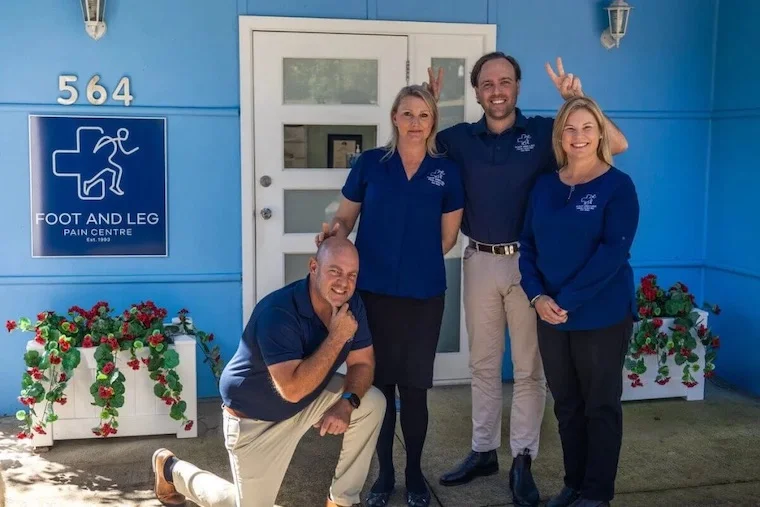
A Reliable Team for Your Care
Dr Angus Chard, PhD, is an acclaimed Certified Sports Podiatrist with a global reputation, bringing years of clinical knowledge to his leadership of a collaborative team.

Dedicated to Helping
The Foot and Leg Pain Centre team works tirelessly to assist people of all ages, including children, in reaching their goals and managing their pain effectively.
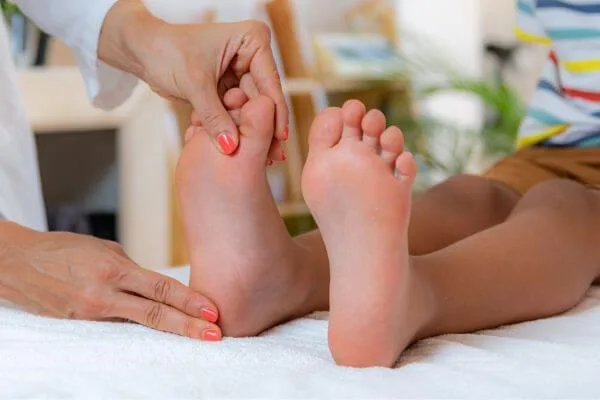
Evidence-Based Care
Along with our cheerful approach and knack for helping children feel comfortable, we deliver treatments that combine scientific evidence with clinical expertise. We offer clear information and treatment choices, ensuring a supportive and stress-free experience.
Helping Little Feet And Legs
At Foot and Leg Pain Centre, we provide a variety of treatment options. The best approach for your child will depend on factors like the location, type, and cause of their pain.
Some children might benefit from 3D printed custom orthotics, while others may require follow-ups, footwear guidance, foot strengthening exercises, posture and biomechanical assessments, manual rehabilitation, or adjustments to their walking and running techniques.
Meet Our Founder
Dr. Angus Chard PhD
Dr Angus Chard PhD, our Founder and Director, is a Certified Sports Podiatrist with 32+ years of experience, committed to guiding young patients towards treatments that combine proven evidence and practical effectiveness.
Happy kids start with healthy feet – arrange an appointment with Dr Angus Chard PhD or one of our experienced podiatrists near Westmead today.
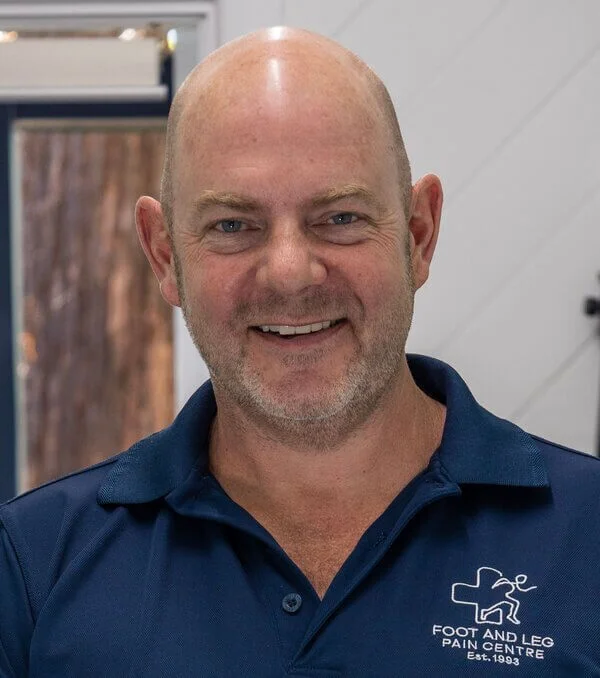
Meet The Team

Michelle Cuthbert
Michelle Cuthbert brings 20+ years of podiatry experience and a strong focus on children’s foot care. As a runner, she appreciates the need for early intervention and, as a mother of two, is deeply committed to helping children flourish through personalised treatment.
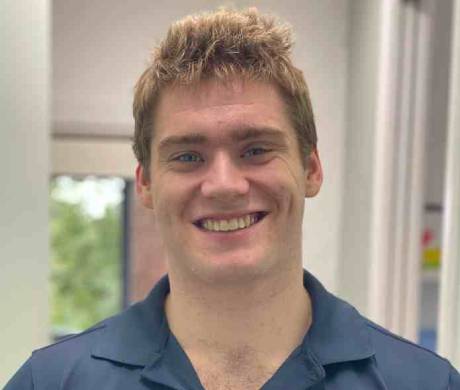
Thomas Shannon
Thomas Shannon, a talented podiatrist and elite athlete, has a strong interest in paediatric lower limb care. Leveraging his expertise in strength, conditioning, and athletics, he provides tailored care for young patients. Thomas proudly represented Australia in hammer throw and Olympic weightlifting.
Foot And Leg Pain Centre
Book Now
Paediatric Assessment
Tiny feet deserve big care – schedule your little one’s podiatry appointment today.
Foot And Leg Pain Centre
Frequently Asked Questions
In some instances, yes, but it’s crucial to have your child assessed to ensure they do. Ignoring problems can lead to unnecessary pain and missed treatment windows. Podiatry intervention helps identify and correct potential issues, supporting pain-free growth for your child.
Although occasional aches from activity are reasonable for children, persistent achy legs and feet are not. Persistent growing pains are easily treated by addressing the muscle overuse that causes them.
Flat feet in children have been linked to quick fatigue during activities and more pathological movements in the knees and ankles. While foot arches mature by age eight, 39% of adolescents with flat feet are at risk of knee pain, and 35% may develop hip or back issues. Walking patterns mature by age four, and failing to address abnormal foot positions can result in persistent issues like toe-walking or pigeon-toed walking into adulthood.
An early assessment is the best approach for ensuring your child’s healthy development. At the first visit, we’ll take precise measurements and perform a detailed biomechanical and gait analysis. This helps track growth and catch issues early. Children, including infants, can develop foot and leg concerns, so prompt care from an experienced provider is essential.
There’s no need for a referral to book a podiatry visit. Whether online or by contacting the practice, we’ll handle everything during your first consultation.
Having your child’s feet checked, like their eyes or teeth, is essential. If they’re experiencing pain, we can provide support. Even if you’re unsure, an initial assessment can identify potential issues and recommend a solution. For emergencies, remember to call 000.
Comfortable footwear for children must have the right length, width, and sufficient toe space. Studies confirm that barefoot movement supports stronger, healthier feet. Direct sensory input from the ground helps activate muscle function for development, but even flexible minimalist shoes can hinder this natural feedback.
Selecting the right shoes for your child depends on the intended purpose. Barefoot-like, flexible footwear may suit some situations, while more supportive styles with different levels of support may be required in others. Look for shoes with flat, flexible soles that bend near the toes and a front wider than the heel. Secure fasteners such as laces or straps help keep feet comfortable and prevent slipping.
The Foot and Leg Pain Centre, led by Dr Angus Chard PhD, offers the experience and industry connections needed to simplify the often-confusing world of footwear choices. For specific guidance on your child’s foot health, schedule a consultation with our podiatrists today.
Certainly, we do. That said, we also prioritise blending evidence with real-world experience, as evidence alone doesn’t always tell the full story. Below, you’ll find references supporting the information presented here.
- Alfaro-Santafé, J., et al. (2021). “Effectiveness of Custom-Made Foot Orthoses vs. Heel-Lifts in Children with Calcaneal Apophysitis (Sever’s Disease): A CONSORT-Compliant Randomized Trial.” Children 8(11): 963.
- Bleck, E. E. (1983). “Metatarsus adductus: Classification and relationship to outcomes of treatment.” Journal of Pediatric Orthopaedics 3(1): 2-9.
- Chard, A., et al. (2011). Effect Thong Style Flip-Flop Footwear On Children’s Hallux Sagittal Plane Motion During Gait. International Society of Biomechanics, Brussels, Belgium, publisher.
- Chard, A., et al. (2012). “Effect of thong style flip-flops on children’s midfoot motion during gait.” Journal of Foot and Ankle Research 5(Suppl 1): O19.
- Smith, R., et al. (2012). “Biomechanics of footwear design.” Journal of Foot and Ankle Research 5(Suppl 1): I1.
- Chard, A., et al. (2013). “Effect of thong style flip-flops on children’s barefoot walking and jogging kinematics.” Journal of Foot and Ankle Research 6(1): 8.
- Chard, A., et al. (2015). Effect of thong style flip flops on children’s sidestep kinematics International Society of Biomechanics in Sport, Poitiers, France, Sports Biomechanics.
- Chard, B.A., The effect of unsupportive and supportive footwear on children’s multi-segment foot dynamics during gait. 2017. USYD Thesis – DOWNLAOD HERE http://hdl.handle.net/2123/18659
- Gijon-Nogueron, G., et al. (2016). “Establishing normative foot posture index values for the paediatric population: A cross-sectional study.” Journal of Foot and Ankle Research 9(1): 1.
- Kothari, A., et al., Are flexible flat feet associated with proximal joint problems in children? Gait and Posture, 2016. 45: p. 204-210.
- Lin, C.-J., et al., Correlating factors and clinical significance of flexible flatfoot in preschool children. Journal of pediatric orthopaedics, 2001. 21(3): p. 378-382.
- Mauch, M., et al. (2008). “Foot morphology of normal, underweight and overweight children.” International Journal of Obesity 32(7): 1068-1075.
- McKay, M. J., et al. (2015). “1000 Norms Project: protocol of a cross-sectional study cataloging human variation.” Physiotherapy.
- Mickle, K. J., et al. (2006). “The feet of overweight and obese young children: Are they flat or fat?” Obesity 14(11): 1949-1953.
- Mudge, A. J., et al. (2014). “Normative reference values for lower limb joint range, bone torsion, and alignment in children aged 4-16 years.” Journal of Pediatric Orthopaedics Part B 23(1): 15-25.
- Redmond A, Crane Y, Menz H. Normative values for the Foot Posture Index. Journal of Foot and Ankle Research. 2008;1(1):6.
- Sanders, R., Orr, R., Chiu, C., Chard, A., Tompsett, C., Fleeton, J., Davies, T., Fong Yan, A. (2018). Development of talent of adolescents in Australian sports high schools. In Pedro Morouço, Portugal: ESECS/Instituto Politcnico de Leiria.
- Staheli, L., et al. (1985). “Lower-extremity rotational problems in children. Normal values to guide management.” J Bone Joint Surg Am 67(1): 39-47.
- Sutherland, D. H. (2001). “The evolution of clinical gait analysis part l: kinesiological EMG.” Gait & Posture 14(1): 61-70.
- Sutherland, D. H. (2002). “The evolution of clinical gait analysis: Part II Kinematics.” Gait & Posture 16(2): 159-179.
- Sutherland, D. H. (2005). “The evolution of clinical gait analysis part III – kinetics and energy assessment.” Gait & Posture 21(4): 447-461.
- Wegener C, et al. (2011). “Effect of children’s shoes on gait: a systematic review and meta-analysis.” Journal of Foot and Ankle Research 4(3).
- Wegener, C., et al. (2013). “Effect of sports shoes on children’s vertical jump performance and midfoot and ankle kinetics.” Footwear Science 5(SUPPL. 1): S58-S59.
- Wegener, C., et al. (2013). “Effect of sports shoes on midfoot power generation in children while walking and running.” Footwear Science 5(sup1): S55-S56.
- Wegener, C., et al. (2015). “In-shoe multi-segment foot kinematics of children during the propulsive phase of walking and running.” Human Movement Science 39: 200-211.
We are an approved and audited NDIS provider, welcoming all NDIS patients, including those who are self-managed, agency-managed, or NDIS-managed. We prioritise providing a personalised experience and are mindful of the extra time some appointments may require. From accommodating heightened touch sensitivity to assisting with wheelchairs or other specific needs, we are experienced and ready to help.
We are trusted by thousands of happy patients and our results speak for themselves






Families in Dural, NSW, and nearby suburbs trust the Foot and Leg Pain Centre for paediatric podiatry. We serve patients from Westmead, Richmond, Arcadia, Bella Vista, Castle Hill, Cherrybrook, Galston, Glenhaven, Hornsby, Kellyville, Northmead, Norwest, Rouse Hill, Westleigh, Kenthurst, Parramatta, Seven Hills and more areas for paediatric podiatry. Secure your child’s appointment today!


